These include almost all multi-storey residential buildings of the Soviet era, as well as industrial construction sites and shopping centers, where, for economic reasons, it is impractical to have flat roof... This type of roof is divided into two types:
- operated (located on the roofs of summer restaurants, cafes, viewing and walking areas),
- unexploited, not requiring additional reinforcement.
It is one of the simplest types of roofs. The construction of such a roof does not require large expenditures of money and amount of work.
To build such a roof, certain conditions must be met:
- bias,
- the whole structure must be waterproofed and have a drain for rain and waste water,
- roof insulation.
When arranging a roof terrace, the required slope has great importanceas it serves as waterproofing.
The necessary device for water drainage can be made using gutters. Best to apply inner tube heated so that ice does not form inside it in winter.
The base of the roof can be made of concrete. The concrete should be insulated with special materials, then a layer of waterproofing should be laid on the thermal insulation, with special attention should be paid to the areas most susceptible to wetting, for example, the connection of the wall and the roof.

As stated above, flat roof has several varieties.
Varieties of flat roofing.
Operated... This type settles for such a purpose that people will go out to it. For example, to repair and inspect coatings and waterproofing or ventilation systems.
One of the important conditions when creating such a roof is the construction of a fence around the entire perimeter, which must be stable and reliable. Internal and external drainage systems are also important.
Unexploited flat roof... Usually it is used on structures with a small area, for example, it can be a garage, warehouse, bathhouse or gazebo. Since people are not provided with access to it, the rigidity of the foundation does not play a special role.
Another type of roof is inversion. It implies active exploitation. For example, this type of roof can house restaurants, cafes, winter gardens or parking lots.
All calculations should be done by professional engineers. Only they will be able to calculate floors, thermal insulation and waterproofing.
When building private houses, flat roofs can be made of wood. In this case, waterproofing is also of great importance.
In any form flat roof it must have:
- vapor barrier layer,
- high-quality waterproofing,
- insulation layer,
- roofing covering.
Insulation should be selected depending on the type of roof, for example, on an unexploited one can be used soft materials, and in the case of an exploited roof, it is necessary to use only rigid types of insulation coating.
Flat roof consists of several layers:
- grounds,
- vapor barrier,
- insulation,
- waterproofing, which is also a roof covering.
Vapor barrier protects the insulation from the warm air that enters through the ceiling. Various materials can be used as a vapor barrier, for example, a vapor barrier film or fiberglass.
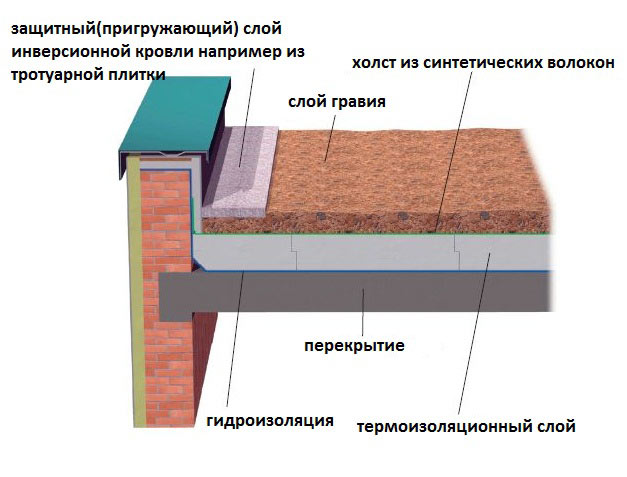
In places where the vapor barrier is connected to vertical surfaces, it is brought to a height that is greater than the thickness of the insulation and the roof covering. A sealant or hot bitumen is added to the joints.
For houses that are intended for use, usually the insulation is polystyrene, expanded polystyrene or other insulation materials that have a solid structure.
Bulk mixtures can be used as insulation, but not on actively exploited roofs. In this option, a sand and cement screed is poured over the free-flowing coating.
By choosing flat roof covering, quality should be made a guideline waterproofing material, because the effectiveness of the coating and the elimination of leaks depend on it.
The pros and cons of a flat roof.
The main advantage of this type of roof can be attributed to efficiency, since when arranging it, the material will require 1.5-2 times less than when constructing other types of roofs, for example, pitched ones. As a result, space heating is saved, since a small roof area gives off less heat to the atmosphere.
The disadvantages of such a roof include:
- not very attractive external house view,
- a high-quality drainage system is required,
- the obligatory presence of a strong and reliable waterproofing system.
If on flat roof the attic space is not provided, then the insulation should be carried out both outside and inside the room.
Thermal insulation can be laid in one or several layers. It depends on the temperature conditions of the region.
Any roof must have a slope, even if it is called flat. This is done to ensure that water flows unhindered into gutters and funnels.
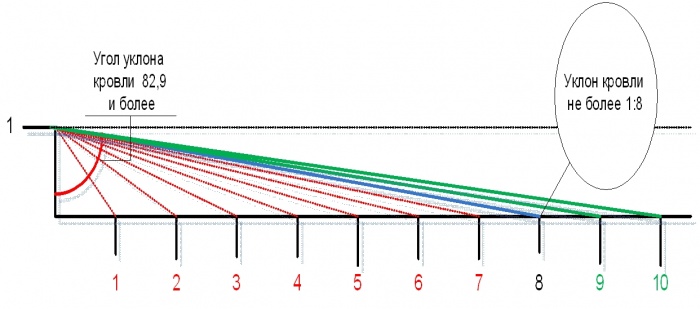
On residential buildings, the slope is 1-5 degrees. If this is not done, then water will accumulate on the surface of the roof, which will further render the coating unusable.
If the precipitation that fell in the summer can evaporate, then the precipitation that fell in the autumn goes through a repeated cycle, that is, it freezes, then melts and so on in a circle. As a result, the top layer of the roofing is destroyed and water penetrates into the insulation material.
If the slope on the roof is insufficient, then moisture enters under the waterproofing layer, as a result of which leaks begin. In addition, dust gets into the ever-standing puddles, which settles, and the seeds of various plants are brought by the wind, which later grow, turning the roof into oases. You can often see a picture where not only grass but also trees grow on the roof. To avoid these undesirable consequences, it is necessary to roll the roof. This is done at the stage flat roof devices... All related processes are aimed at acquiring the required bias.
A flat roof looks like a kind of multi-layer cake, the layers of which are:
- the base, represented by an iron floor slab or a metal profile of a certain height,
- steam insulation rolls materials,
- insulation having a different structure,
- several layers of roll waterproofing,
The slope is made directly at the stage of laying the insulation material. In order for the drainage to have sufficient efficiency, the minimum slope of the slope must be from 1 to 4 degrees.
In addition to all other components, the roof structure with an internal drain must have drain funnels. If the drainage system is located outside the building, then gutters are installed, which are arranged on the outer wall of the structure or under the roof covering.
To achieve the required slope, several methods are used:
- using bulk materials,
- using a mixture of concrete with the same fillers,
- using a concrete mixture with polymer fillers,
- using insulating materials.
When flat roofing bulk materials are not entirely convenient, since they have great mobility. During the work, the material can move, and, accordingly, the angle of inclination may differ from the specified parameters.
In order for the bulk material to take a stable shape and maintain the given slope parameters, it must be poured with a cement composition and wait a while for the material to set.
So, flat roofs have recently become quite popular among the population, as they significantly help save space. On such a roof, you can install a summer cafe, an observation deck, a restaurant or a parking area.
When constructing such a roof, all its features should be taken into account, the main of which is high-quality and reliable waterproofing... If all calculations are made correctly and all the basic nuances of a flat roof device are provided, then it will have a long service life. The insulation and ventilation system is also an important point.
Flat roof will help save not only on space, but also on materials.
Modern construction companies use different methods work and.
In most cases, the best option is sought when the price matches the quality.
This is important, since in times of fierce competition, the consumer is looking for an opportunity not only to get a high-quality structure, but also to save money.
Operated roofs are often used in the hotel business.
It's no secret that land in resort towns is especially expensive.
Here every centimeter is always used for its intended purpose.
The ability to equip the rooftop for guests to rest can significantly save money and maximize the space for relaxation.
The particular is no exception. So today, building cottages, many people prefer exploited roofs, because a terrace or green area equipped there will be much more convenient and original than a banal balcony.
Flat roof. Concepts and types
Flat roofs are in high demand among customers construction companies... Significant cost savings, low labor costs, the minimum amount of materials used and the speed of implementation allow this type of roofing to occupy a leading position.
One of the main features is the possibility of additional operation of the roof of the house. This type of roofing is used for industrial and residential.
Experts define four types of flat roofs, which have their own advantages:
- Flat, unexploited roofs. It is used in the event that the building design does not imply the use of the roof for any additional purposes.
- Operated flat roofs. They are used when the customer plans to use the surface for additional purposes. can serve as an open terrace restaurant, a helipad. This roofing will cost the client much more, but these costs are justified. An exploited flat roof is more reliable and can last much longer.
- Inversion coating. This type has its own technological features. In this case, it is the laying of the insulation directly on the waterproofing layer, which has not been previously exposed to mechanical, temperature and ultraviolet exposure. The insulation is protected from external influences by means of a drainage layer. Only after this is it possible to lay the finishing layer, as it can be paving slabs. In modern construction, this type of roof is often used in the construction of multi-storey parking lots.
- Traditional. The name of this type of roof speaks for itself. Technologies have been familiar for a long time, tested, and show good results.
Operated flat roof. Features of the structure
If you are planning a device for an exploited flat roof, the technology for its creation must be thoroughly studied. The service life, as well as the safety of everything, depends on the accuracy of project development and a thorough study of all the smallest nuances.
The modern roof structure of this type depends, first of all, on the purpose of its creation, as well as on the type of building and the materials used in the work.
Usually, this roof is created from the following parts:
- Reinforced concrete base plate
- Vapor barrier
- Thermal insulation
- Waterproofing
Coverage provided. This can be a layer of filled soil if a "green zone" is created on the roof or paving slabs when creating a terrace or multi-level parking lot.
This finishing layer is preceded by the installation of a drainage or concrete screed. The choice depends on the purpose of using the surface.
When creating a roof, regardless of its type, special attention must be paid to hydro and thermal insulation, as well as water drainage. In any case, it will accumulate on the surface as a result of rain or melting snow, so this issue must be treated with special attention.
The choice of material for covering an exploited flat roof should be based on a long service life and a high level of resistance to fire.
It is considered one of the most the best materials, which for covering a flat operated roof, is stone wool. Modern specialists often use non-combustible materials for insulating an exploited flat roof.
This is not only done in the interest of fire safety. By using such materials, you can reduce the cost of creating expensive fire barriers.
The use of deposited modern building materials allows you to reduce the cost of laying a concrete screed, as there is no need to use it.
There are no special requirements for flat waterproofing. The coating should be:
- Elastic
- Resistant to various mechanical actions
- Refractory
- Retain its properties at large temperature differences
- Have a long service life and have a number of other properties
Everyone who plans to implement the device of an exploited flat roof with their own hands should know that today there are such types of special building materials:
- Materials in rolls based on bitumen, polyester or fiberglass
- Polymer bituminous
- Asphalt roofing mastics and others
Any sales assistant at a hardware store can tell you in detail about their properties, advantages and disadvantages. These modern materials have a long service life and can reliably serve from 15 to 75 years, which is its main advantage over the previously used roofing felt.
If, according to the project, a green zone is planned on a flat exploited roof, it is necessary to lay a layer of geotextile between the drainage and the ground. It will act as a filter and prevent small soil particles from being washed into the drain.
Thus, the geotextile prevents flooding of the drainage system and makes it more efficient.
A flat exploited roof makes you pay special attention to the system. For the green zone, it is imperative to equip a small slope. It will allow the water to not accumulate and quickly drain into the water reservoirs.
What are exploited flat roofs used for?
Exploited flat roofs brought some variety to the construction. They can be used for various purposes, thereby expanding the usable space.

Multilevel car parks are one of the most popular applications.
Such roofs allow you to create a number of additional parking spaces, clearing the area around the office or home from cars.
Flat operated roofs are also used in construction.
This is ideal for creating a terrace.
Such a comfortable place to relax will allow the inhabitants of the house to spend in the fresh air large quantity time.
Such terraces are often found in small private hotels. Thus, the owners of the hotel build places for their guests to rest.
Today, a green area is often built on flat roofs. They are installed not only in private houses, but also on the roofs of offices. Communication with nature allows you to relax well after a hard day.
Innovative materials for the arrangement of exploited flat roofs
Modern technologies and building materials make it possible to declare with confidence that the operated flat roofs are quite reliable and practical. They are capable of withstanding any load, and forgive the test of time and bad weather conditions.
To create a roof of this type, both well-known time-tested materials are used, as well as those that have been talked about only in recent years.
So popular and often used today is stone wool. It is used to insulate a flat roof. This wool is made from gabbro-basalt rocks.
Thanks to the use of this material, the life of the roofs, their reliability, and resistance to external influences have increased significantly. The roof, insulated with stone wool, has good hydro and vapor barrier.
The material is environmentally friendly. Stone wool is able to withstand temperatures up to a thousand degrees, so this material is said to be the ideal solution to provide protection from fire.
Stone wool also has its drawbacks. This is due to possible problems with its installation. Today this problem has been resolved.
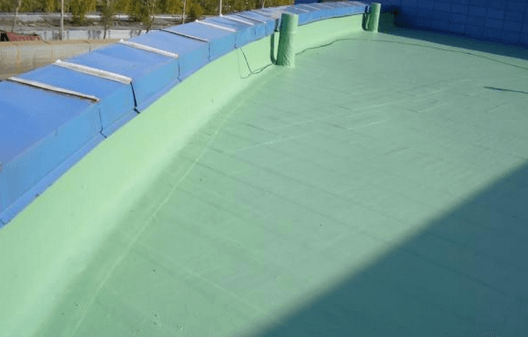
For work, stone wool slabs with different densities are used.
The upper layer is more rigid and the lower one is less dense.
Another innovation that is used today for waterproofing flat roofs is a polymer membrane.
The material has a long service life.
Builders love to use it also because the membrane is relatively lightweight.
This reduces the load on the supporting structure.
Roofs, in the manufacture of which such a membrane was used, are resistant to combustion and are distinguished by increased resistance to the effects of sun rays. Membranes are usually attached in three ways:
- Ballast fixing. This option is considered affordable and convenient. In this case, the membrane is simply laid on the surface, and it is attached exclusively along the perimeter and at the points of abutment to vertical surfaces. The membrane is held with ballast, which is used as paving slabs, reinforced concrete blocks or gravel. This method is most often used for roofs, which, in addition to their own weight, will have to withstand mechanical stress.
- Mechanical fastening. If it is necessary to reduce the load on the supporting structures, experts recommend using this method of fastening. The process is quite simple and does not require special skills and tools. The cover is fastened at the seams using anchor plates. They are pressed with special screws to the membrane.
The membrane is completely glued to the base. This method is used on roofs with complex configurations and in case the roof will be exposed to strong mechanical loads. For work, use assembly glue. Care should be taken when choosing an adhesive, as it must be compatible with the material of the thermal insulation and membrane.
DIY installation work. What errors occur
It is quite possible to carry out the installation of an exploited flat roof on your own today. On the Internet there are a huge number of sites and all kinds of forums where you can find not only step by step instructions to implement installation works... But also ask questions to professionals who can tell in detail about each of the stages of installation.
Instructions allow purchasing required material, because usually they are accompanied by calculations made by specialists. It is very important to follow all the recommendations and strictly follow the advice. This will help to avoid possible errors that may arise at any of the stages.
So, when installing insulation, it is important to avoid the formation of "cold bridges". The loss of heat in this case can be very serious and reach 50%. The result of such a violation of the installation can lead to the appearance of condensation, and subsequently mold.
The reason for the appearance of such "cold bridges" can be banally simple. They can occur as a result of the use of dowels with a metal nail.
A similar problem is eliminated when using stone wool as insulation for a flat roof. In this case, according to the technology, assembly glue or special dowels with a plastic rod are used to fasten the insulation.
If you doubt the quality of your work, and for some reason do not want to hire professional builders, play it safe and use a two-layer insulation. In this case, special attention should be paid to the order of laying the top layer.
It is laid in such a way that the upper insulation plates cover the seams of the lower layer. Experts recommend using large slabs. This will make it possible to reduce the number of seams, keeping heat loss to a minimum.
Recently exploited flat roofs have become often used in. it perfect solution in the case when it is necessary to increase the space, or want to create a small and cozy place to relax.
Such roofs are often equipped after major repairs, especially in situations where there is no balcony in the home. This is a great opportunity to make your home more comfortable and modern.
The process of arranging an exploited flat roof is quite simple. The work involves the use of affordable materials. Due to the low labor costs, almost everyone can afford to equip this type of roof.
Availability of materials and the ability to get on the Internet detailed instructions allows you to do this work yourself. Often such a platform is set up on the roof of the Khrushchevs.
These flat roofs are completely precarious, and often result in heat loss. Arrangement of the operated roof will allow not only to create a comfortable landscaped terrace for yourself, but also to insulate the apartment, additionally protecting it from above with reliable high-quality materials.
Create such a roof yourself at home, and your terrace or green area will become a favorite resting place for guests and a serious reason for pride. And how to insulate it, you can watch the video:
There are several types of roofing depending on the shape: single-pitch, gable, complex and flat. The latter option is the fastest, but at the same time technologically difficult. Check out the technology for self-erecting a flat roof with your own hands.
Flat roof device and the principle of its construction
Flat roof - has a fairly simple configuration, and with the right approach, the construction process takes a maximum of two days. First of all, decide on the construction technology, draw up a project, purchase and prepare materials for work.
On load-bearing walls, install wooden or steel beams that transfer the load from the roof to the walls and foundation.
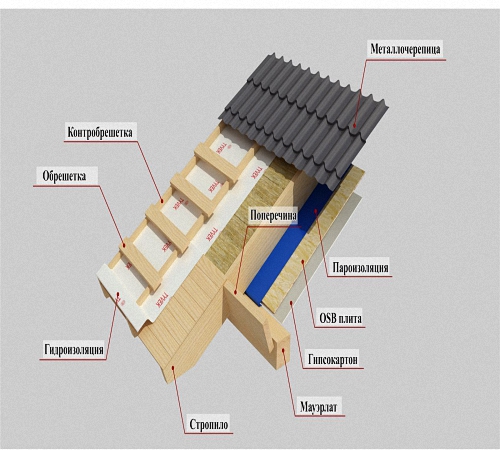
In addition, beams perform several other important functions, such as:
- total weight retention attic space and floors;
- the weight of people who repair and maintain roof structures;
- wind loads, the weight of precipitation that accumulates on the roof.
For correct selection diameter and size of the beam, take into account all the loads that act on them. Also, for a high quality flat roof, choose the right finish that is reliable and good in performance.
One of the most important stages is heat and sound insulation. The flat roof of capital buildings is represented by floor slabs, on top of which a heat and waterproofing cake is laid:
1. Initially, a vapor barrier is placed on the surface to prevent moisture penetration to the insulation. For the manufacture of vapor barrier, reinforced bitumen film based on fiberglass is most often used. The edge of the film is wound behind the vertical line of the overlap, and all seams are carefully soldered.
2. Installation of insulation is the next step. It is possible to use expanded clay for surface insulation, initially a concrete screed is installed on it, and with a lightweight version of the roof, they are used solid options polymer insulation.
3. The most important and final layer is waterproofing. The service life of the roof as a whole depends on the quality of its execution. Most often, flat roof waterproofing is performed using polymer-bitumen materials.
There are two options for a flat roof, in relation to the type of room for which it is being built:
- flat roof for a heated room;
- flat roof for an unheated room.
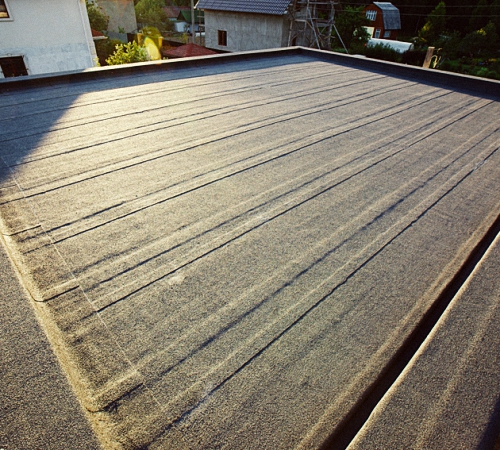
The erection of a flat roof over an outbuilding, a shed, a gazebo does not require special skills. A slight incline to one side is sufficient to create a stack.
The process of creating a flat roof for a heated room is divided into stages:
1. On the laid beams, a boardwalk is installed, which is covered from above with roofing material or roofing felt with a large overlap.
2. Insulation is laid on roofing material, which is based on expanded clay or slag. When filling the insulation, adhere to a certain slope, in relation to the discharge of melt or rain water from the roof.
3. A cement mortar-based screed is installed on the insulation, at least two centimeters thick. After it has set, the material is processed with a bitumen-based primer. A roll carpet is additionally glued to the screed.
It is recommended to create a flat roof with a minimum span, thus reducing the difficulty of waterproofing and thermal insulation. Roofs with a width exceeding 600 cm are recommended to be erected only with specialists. Incorrect calculation of loads on beams leads to dire consequences: incorrect distribution of the load and a decrease in the operation of roofing materials.

Monolithic concrete flat roof installation technology
As load-bearing structure for a concrete flat roof, two-T-type steel beams protrude. If the roof span does not exceed 500 cm, then 15 cm thick beams are used to equip the roof.
- crushed stone, fraction 1-2 cm;
- cement grade 400.
The ingredients are combined in the amount of eight buckets of rubble and three buckets of cement, four buckets of sand and two buckets of water.
This is followed by the process of installing boards on the lower shelves of the beams, roofing material is mounted on the boards and reinforcement mesh, from minimum size cells of 10 mm. To connect the intersections of the mesh, use a knitting wire or a welding machine. The gap between the mesh and the roofing felt is about 4-5 cm, for this, rubble is laid under the mesh. In this case, the thickness of the concrete layer is at least fifteen centimeters.
At the same time, the stripes are stacked evenly, it is not allowed to leave an unfinished strip until the next day. This negatively affects the quality of the roof structure. The best option is to fill the roof within one day. After pouring, the surface is compacted with a vibrator on concrete or hand tool... When compacting concrete, be careful not to deform the mesh.
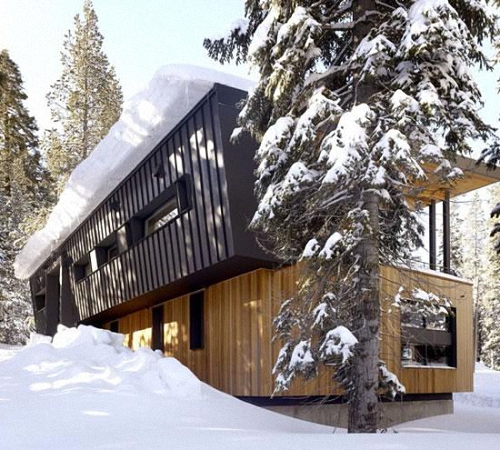
Next, a polyethylene film is installed on the roof to prevent excessive moisture evaporation and cracking of the top layer. After the roof is completely dry, a slope is constructed with the help of a heater to drain the water.
Do-it-yourself flat roof thermal insulation
A flat roof differs from standard single-pitched and gable types, the need for both internal and external insulation. First, the roof is insulated outside, and, if necessary, inside.
Previously, for the insulation of a flat roof, rigid thermal insulation boards, but due to their high weight, at present, they are practically not used. The substitute for this insulation has become heat-insulating materials based on basalt and mineral wool. Thermal conductivity of this material much higher, and the weight does not make the structure heavier.
In addition, the insulation perfectly resists mechanical damage and has a high fire safety. Internal insulation of a flat roof is carried out with the help of refractory structures, 2-3 cm thick. For mounting the plates on the ceiling, wooden strips are used, on which the plates are fixed with special glue or mastic. Please note that before insulating the ceiling, all lighting fixtures on the ceiling are dismantled.
In addition, materials are used as insulation for a flat roof in the form of:
- mineral basalt wool - does not need an additional protective tie;
- extruded polystyrene foam - an excellent option for a roof that is in constant operation, does not burn, has good sound insulation characteristics;
- polyurethane foam - does not form butt joints, does not burn and is used as insulation for a soft roof;
- ecowool - contains cellulose, has an additional flame retardant coating, therefore it has a high level of safety;
- foam concrete - it has a monolithic structure and a long service life, is similar in structure to foam, ideal for insulating a flat roof without creating significant loads on the foundation.
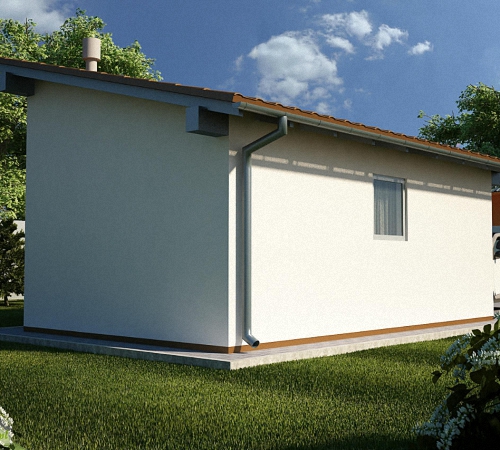
Flat roofing and roofing pie technology
In order to obtain an ideal roofing covering with good sound, heat and waterproofing characteristics, you must first create a drawing of the roofing pie, which consists of:
- bearing base - concrete or steel beams;
- vapor barrier layer;
- thermal insulation layer;
- waterproofing.
It is possible to change the sequence of layers and add additional materials, it depends on the individual characteristics of the roof and the building itself. In addition, after the insulation, a textile layer is laid, then covered with rubble and finishing is performed. Such a roof is called inversion roof and is used extremely rarely, due to its heavy weight. It is suitable for buildings with high fire safety requirements.
The device of a flat roof implies compliance with all loads that arise during operation. In relation to this indicator, the thickness of each layer in the roofing cake is calculated.
There are several types of flat roofs in relation to structural characteristics:
- non-insulated roof;
- insulated roof that has open and closed systems 4
- monolithic roofs;
- inverted roofs.
![]()
In relation to the operational load, a flat roof is:
- operated;
- not exploited.
Depending on the drain:
- flat roof with internal drain;
- flat roof with external drain.
Diy inverted flat roof
The inverted flat roof has good performance and high fire safety. The installation technology for this roof option is as follows:
- laying waterproofing;
- installation of thermal insulation material;
- geotextile component;
- drainage system;
- protective bulk coating.
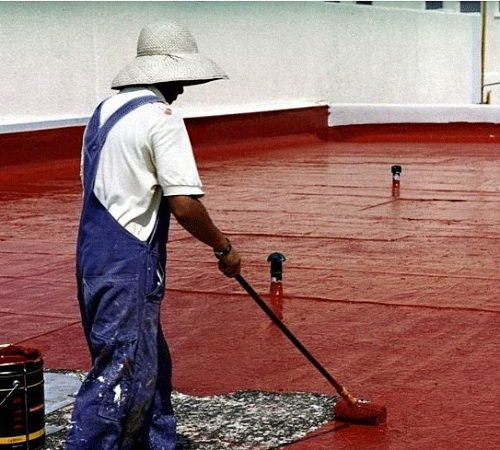
Among the advantages of this type of flat roof, we note:
- the complexity of the destruction of waterproofing;
- no condensation on the insulation, since it is located on top of the roofing cake;
- ease of repair and replacement of thermal insulation material.
Excessive moisture that forms in the thermal insulation layer causes a deterioration in the protective characteristics of the roof as a whole. Soon it becomes covered with cracks and bubbles, especially in the summer season, when the insulation releases moisture. The complete absence of ventilation leads to flaking of the roof from the base.
In this case, we recommend installing a breathable roof. For the manufacture of the roof, roll materials are used, with excellent tightness and long service life. Between the bituminous mastic install thermal insulation material, and roof aerators are used for additional ventilation. Among the advantages of this coating, we note:
- no need to dismantle the flooring, additional strengthening of water protection;
- laying the second layer with a slope leads to an improvement in moisture removal;
- the possibility of using this method both during the initial installation of the roof and during repairs.
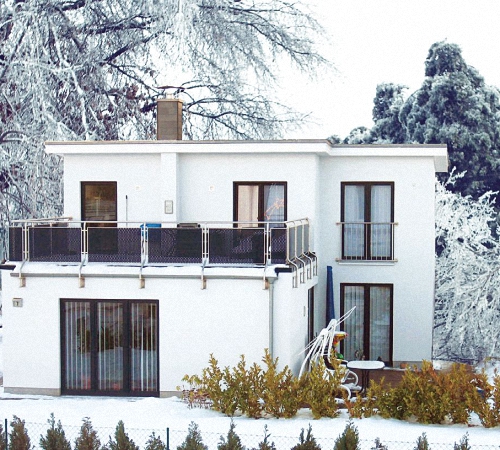
DIY flat roofing instructions
Materials for finishing a flat roof must meet certain requirements, such as:
- high level of strength;
- a light weight;
- heat insulation and sound insulation characteristics;
- resistance to ultraviolet radiation;
- duration of operation;
- ease of installation and maintenance.
Quite often, roofing material with glassine is laid on a flat roof, however, these materials are not distinguished by a durable service life, they do not tolerate frost well and are destroyed under the influence of temperature fluctuations. Every 8-10 years of operation, the roof is re-covered with roofing material.
New roll-bitumen coatings are gradually replacing roofing material with glassine. This is due to their such advantages:
- excellent performance characteristics;
- ease of installation;
- complete waterproofing of the roof;
- resistance to chemicals, temperature extremes;
- duration of use.

There are several types of bituminous materials for flat roofing:
1. Fiberglass, fiberglass - it has high strength, resistance to mechanical damage and absolute moisture resistance.
2. Bitumen materials based on polyester or polypropylene. They are used as a lower layer of protective coatings, have a high density, good waterproofing performance and are used on reinforced concrete floors.
Polymeric membrane materials are based on reinforced plastic mesh, rubber and polymer resins. The cost of such materials is much higher than that of bituminous ones, however, compared to the latter, they have certain advantages:
- light weight, therefore they do not load the foundation and base of the building;
- elasticity and tendency to stretch;
- duration of operation, which exceeds 50 years;
- do not need to use open fire for installation, compared to bituminous materials;
- hot air is used to join the joints.
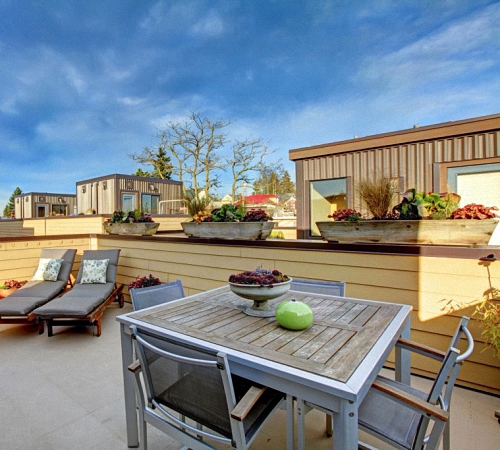
Mastic based materials are ideal for flat roofs. Roll materials, although they have certain advantages, they all create seams that, under increased load, allow moisture to pass through. Seamless mastic roofing does not create butt joints and is characterized by perfect smoothness. Such a roof is called “bulk”. This roofing is easy to apply, forming a solid sheet; a brush or brush is enough to level the material. Previously, the roof is treated with soil or primer.
Flat roof do it yourself video:
A flat roof is the most inexpensive and affordable option for roof construction. It is widely used in the arrangement of both residential buildings and industrial structures. Depending on the purpose, it may have an unexploited or exploited surface. The slope of a flat roof (necessary to drain precipitation), as a rule, does not exceed three degrees.
Why a flat roof is better than a pitched roof: the main advantages
A flat roof is a more economical roof arrangement than a pitched roof. With an equal building area, the area of \u200b\u200bthe first less area the second - which means that less materials are required. A flat roof is being "erected" under conditions of "low extremity", therefore, we can talk about reducing the complexity of installation work.
Subsequent maintenance of the surface is also simplified - cleaning of gutters, inspections of chimneys and ventilation ducts, etc. A specialist working with your building does not need the skill of a climber. It is also nice that projects of houses with a flat roof allow you to mount climatic equipment (for example, outdoor units of air conditioners) without touching the facade.
But there are moments in which a flat roof loses a pitched one. For example, it “suffers” more because of snow loads.
Types and features of flat roofs
A flat roof can be exploited or unexploited, traditional or inverted.
Operated coating
It must necessarily have a rigid base (the goal is to preserve the integrity of the waterproofing) - it can be corrugated board or a concrete screed. When insulating such a roof, it should be remembered that the heat insulator will be subjected to increased dynamic and static load - therefore, it must have a high compressive strength. If the insulation was not purchased hard enough and nothing can be done about it, you will have to form on top of it additional layer cement screed.
Recently, special attention has been paid to the equipment of such roofs - an additional area for parking or a summer cafe, given the modern rhythm of life, simply cannot be superfluous. A flat operated roof (terrace type) is a standard structure consisting of:
- reinforced concrete slab;
- vapor barrier;
- heat insulator;
- waterproofing layer;
- topcoat.

The classic version of the device "pie" of a flat roof
The most common option finishing can be called paving slabsinstalled on sand pillows or special stands. It is recommended to install an inverted roof on areas prepared for intensive operation.
The main advantage of an exploited roof, which is easy to guess, is the ability to transform the "ordinary" roof into a cozy quiet corner, where you just want to settle down after a hard day's work.
![]()
On the exploited roof, you can arrange a terrace with a cozy seating area
Non-operational design
Not demanding on the rigidity of the base and insulation. It is much easier to equip it than an exploited one. But this affects the service life of the surface - it is significantly reduced.
Traditional roof
Its construction includes a layer of vapor barrier laid directly on the base. Vapor barrier films are designed to protect the insulation from moisture "from below" (diffuse). They are laid on top of the screed, at the edge of the roof along the vertical plane, they are brought to a height that exceeds the height of the insulation. The insulation can be polystyrene or mineral wool. The surface is waterproofed with bitumen-based materials.
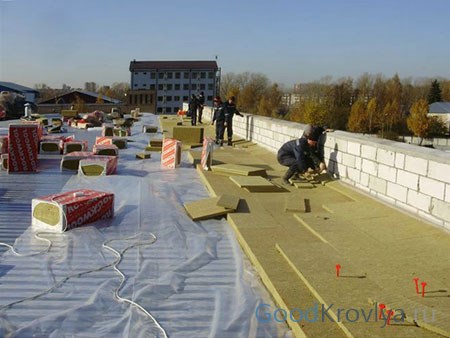
Thus, the process of installing insulation takes place.
Inversion type
Its main difference from a traditional flat roof is the location of the insulating layer not under the waterproofing, but above it. This design protects the waterproofing agent from negative UV effects, mechanical damage and atmospheric "whims".
As a heater, you should use a material that can retain its properties even in contact with moisture (for example, extruded polystyrene). The waterproofing carpet should be made of PVC membranes, bituminous mastics or euroruberoid.
The design of the inversion roof allows its use as an exploited one - it is possible to successfully plant grass on it, equip an area for walking, install tables and sun loungers.
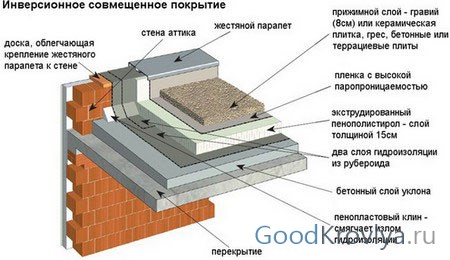
Breathable roof
Most roofing coatings lose their properties due to excessive moisture in the thermal insulation layer. This manifests itself in the formation of cracks, tears and blisters. The most intensely destructive process occurs in summer, when moisture begins to evaporate intensively from the insulation. As a result, the roof is detached from the base.
This phenomenon can be avoided with the help of a breathable roof that ensures high-quality removal of water vapor. To install it, you do not need to completely dismantle the outdated coating - the old fused roofing carpet can calmly act as an additional waterproofing layer.
Green roof
It allows you to solve one of the most important problems of our time - the problem of a lack of communication between man and nature. In addition, it significantly improves the appearance of the structure. Modern landscape designers turn flat-roofed houses into true works of art with exquisite flower beds, English lawns or even a full-fledged park.
Please note that the decision to install a green roof must be made at the stage of building design. The fact is that the soil layer creates a considerable additional load on the floors, and this cannot be ignored.
![]()
Green roof is a great place to stay
A green flat roof should consist of the following layers:
- reinforced concrete construction;
- high quality waterproofing (EPDM membranes, polymer membranes are recommended);
- insulation (extruded materials are suitable);
- geotextile;
- drainage layer (gravel / crushed stone);
- gasket;
- priming;
- vegetation cover.
Depending on the type of use and landscaping, extensive and intensive green roofs are distinguished. The first operation does not imply, the paths are laid solely for the freedom of movement of the service personnel: as a rule, only lawn grass is planted on them, while larger plants are placed in pots. The second is a full-fledged garden with shrubs, flowers and trees. The main condition for arranging an intensive roof is reliable structures and the ability to lay a meter-long soil layer.
It is necessary to entrust the execution of works on installation of a green roof only to professionals, since it will be quite expensive and problematic to repair it after inept "amateur performance".

Rules for the operation of a flat structure
There are a number of necessary requirements for the device of an exploited flat roof:

Typical coating defects and how to fix them
Leaks after rain / after a while
Possible reason:
- mechanical damage or defects allowed during roofing;
- the formation of cracks in the places where the roof adjoins to ventilation shafts, longitudinal and end parapets;
- crack at the junction of floor slabs;
- microcracks of roll material.
- installation of patches on defective spots. The damaged area must be overlapped by at least 15 centimeters in each direction.
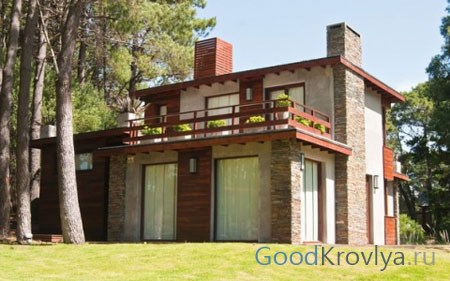
With heavy snowfalls, a significant amount of snow accumulates on flat roofs, which, when melted, can cause leaks
Swelling of the roof carpet - air or water
Possible reason:
- ingress of moisture into the layers of the rolled carpet during the installation or operation of the roof;
- vapor barrier punctures;
- wetting of the insulation.
- Cutting the bulge with an envelope, drying this area. Cleaning the inner surface of the corners from dirt. Heating the base with a propane torch flame, gluing the corners and rolling them with a roller. Patching.
- Complete opening of the roofing at the area of \u200b\u200bblistering. Removal of the screed and thermal insulation layer. Drying out the damaged area. Correction of vapor barrier in accordance with the project. Restoration of thermal insulation, screed and topcoat.

Timely implementation of preventive inspection and repair of the roof will prevent roof leaks at the most inopportune moment
Cracking of the top layer of the roll coating
Possible reason:
- destruction of the material due to solar exposure (due to the lack of a protective layer).
- application of mastic (bitumen-polymer) to the surface with a heat resistance of at least 90 degrees. The optimal number of layers is two, and when applying the second, it is recommended to add aluminum powder to the composition.
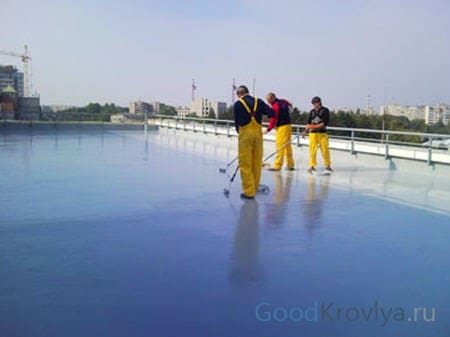
Dampness on the ceiling top floor houses
Possible reason:
- damage to the vapor barrier. Probably a gaping layer, not solid; damaged during installation or not equipped at all.
- complete removal of the roofing "pie" and competent installation of a vapor barrier layer.
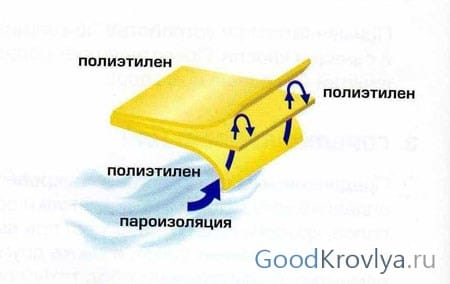
Depressions on the surface of the coating: depth - more than 1 centimeter
Possible reason:
- the base for the roofing carpet has potholes or depressions.
- incision of a rolled carpet with an envelope, correction of the base with a cement mortar. Drying the surface, gluing the folded corners in place, installing a two-layer patch.
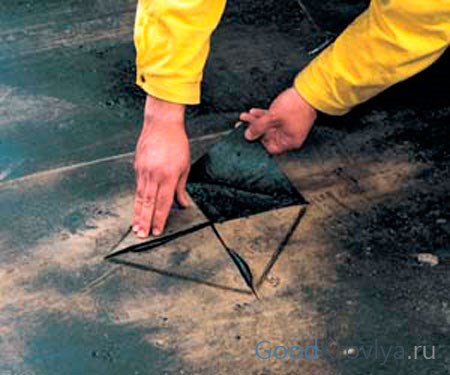
Minor repair of roofing
Peeling of one layer of roofing carpet from another or from the base
Possible reason:
- insufficient heating of the first layer of material when fusing the second;
- installation was carried out on a damp or unclean base;
- concrete or cement-sand screed not previously treated with a primer.
- separation of sheets roofing material in places of delamination, their cleaning and back gluing. Sealing gaps with strips of roll material;
- in the event of a defect spreading over a large area, the complete removal of the exfoliated panels and their replacement with new samples.
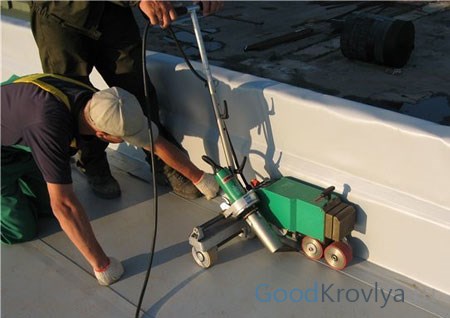
Turning to professionals is the key to the durability of a flat roof
As you can see, a flat roof is both a very simple and incredibly complex thing. So that she serves the house faithfully long years, all work on its installation, maintenance and repair should be entrusted exclusively to the hands of specialists. Not forgetting at the same time to personally control the correct execution of the technology at all stages of the process.



